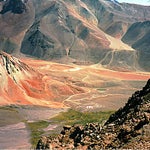When the Dominican government pulled out of the country’s largest gold mine – Pueblo Viejo — 13 years ago, the site appeared to be left for dead. Despite extensive reserves, the mine’s toxic history and the low price of the precious metal, trading at less than $300 an ounce at that point, made for little interest on the part of the private sector. It sat vacant for years and seemed destined for permanent abandonment. Yet, today crews are busy moving tons of earth at what is expected to become one of the world’s largest open pit mines for the precious metal. A joint venture running the mine hopes to cash in on record high gold prices.
Operations such as Pueblo Viejo suggest that mining is back in Latin America. A spike in the price of metals – from the precious, like gold and silver, to copper and iron ore – has led to a rapid expansion in the mining sector. From Mexico to Patagonia, mining companies are exploring as never before and governments are reaping the rewards.
“Mining has gained relevance in virtually all of the Latin America economies since the commodities super cycle started to emerge in the early 2000s,” Alberto Bernal, head of research at Bulltick Capital Markets, recently told trade publication Mining Weekly.
The financial impact of mining is showing up in economic figures. The UN Economic Commission for Latin America and the Caribbean (ECLAC) found the mining sector made up 6.1% of the region’s gross domestic product (GDP) in 2011, up from 4.3% just 10 years earlier. In dollar terms, that means mining has grown from US$90.1 billion in economic activity in 2001 to US$305.8 billion in 2011.
However, as the sector has grown, so too have environmental conflicts and social unrest. Throughout Latin America, residents are engaged in ongoing protests against mines, objecting to either the environmental impact or to the fact that companies failed to meet expectations for job creation and social benefits.
Mining is both a challenge and an opportunity, says Felipe Monteiro, a Wharton management professor and a former Banco do Brazil senior analyst. With appropriate laws in place, and by involving all stakeholders in the development process, Latin American governments and residents can cash in on the mining rush, he says. “There is clearly a recognition on the part of mining companies that they need to develop socially responsible practices.”
New Gold Rush
In few places do fears over mining’s environmental impact and hopes for its economic potential weigh as heavily as the Pueblo Viejo mine in the rolling mountains of central Dominican Republic. There, two of the world’s largest gold mining companies, Canadian companies Barrick Gold and Goldcorp, started pulling gold from the earth earlier this year. The companies have identified reserves of some 23.7 million ounces of gold, 455 million pounds of copper and 88 million ounces of silver.
More than five centuries ago, Christopher Columbus landed not far from the Pueblo Viejo mine on the north coast of the island he named Española. There is evidence that the Indian population that Columbus later exploited, the Tainos, mined for gold at the same spot. It was the gold that Columbus saw Tainoswearing that led him to leave behind at the site 39 men, who built a fort. Those men were dead by the time Columbus returned a year later in 1493, but the search for gold in the Caribbean and Latin America had just begun.
Today, a new Latin American gold rush is underway. While prices for gold futures fell to a six-week low in late October, they are up sharply over the last decade (more than doubling in the last five years). Barrick acquired the mine in 2006, when “the economics were not optimal,” says Andy Lloyd, a spokesman. “We’ve put a lot of work into improving the economics, and we were able to find additional reserve there.… It’s a highly robust mine today.”
For the Dominican government, the attraction was obvious: “Pueblo Viejo Dominican Corporation is authorized to work at the mine for a period of 25 years, and during this time there will be an investment of US$3.6 billion to US$3.8 billion dollars … the biggest foreign investment in the history of the country,” the company said in a statement.
In addition to thousands of jobs, there’s a long-term financial gain for the country. Under the contract between the Dominican government and the companies, the government will receive 3.2% royalties of the gold mined from the site and collect an income tax of 25% plus a 28.75% tax on net profits after the mine recoups its investment. The operation is expected to contribute US$7 billion in direct revenue to state coffers over the next 25 years. The mine is single handedly expected to add 2 percentage points to the nation’s GDP.
Yet, the environmental disaster left behind after the mine was abandoned 13 years ago has left residents fearful. The mine will use some 24 tons of cyanide per day to extract the gold, providing a focal point for their objection. “The past experience of the Rosario Domincana [the state-owned company] of environmental destruction, promises not met and a majority of foreigners taking the best jobs at the mine have contributed to create a strong opposition to mining in the region,” writes Virginia Antares Rodríguez Grullón in a paper critical of the operation.
The company has responded with an environmental program and a public relations blitz that emphasizes transparency. “When people hear ‘Rosario,’ it conjures up images of the environmental legacy that was left behind,” Lloyd says. Changing that perception is “not easy, but it’s [about] just doing the work and being as open as possible. It’s a lot of one-on-one outreach to stakeholders … and a lot of discussion.”
Monteiro says the most socially responsible mining companies involve stakeholders in the process and keep them informed. “If [companies] are able to work with residents and governments, including at the local level, from the beginning, mining can be a strong force for good in these communities,” he says.
Commodity Boom
Many of the same forces that have pushed gold prices north have led to higher prices for commodities in general, which, in turn, is leading to more mining. Many of the mines that have opened in recent years may not have been economically feasible just a decade ago. But two factors have led to an expansion in the sector, Monteiro says. The first is demand, especially from emerging markets, namely China and India. Those countries have pushed up commodities prices. While there has been a slowdown as of late, the long-term expectation is for the growth of commodities prices to continue.
The second trend is supply. “That’s the very interesting thing about this growth” in mining, says Monteiro. “These companies are investing in the infrastructure needed to actually get these commodities to markets, which is increasing supply.” Monteiro cites the Brazilian mining giant Valle, which has built out infrastructure, such as roads and pipelines, making it possible for the company to move products from the country’s interior to seaside ports. “These are long-term investments,” he says.
Mining is already a key driver of the economy in several countries. In Chile, the sector made up 15.2% of the economy, a significant rise from 10 years earlier, when it was responsible for 5.2% of GDP. Extractives makes up 10% or more of the economies of Bolivia, Colombia, Mexico and Venezuela as well, according to ECLAC figures. If current investment trends continue, mining will make up some 12.5% of the region’s gross domestic product within the next decade, researchers at Queensland University suggest in a recent report.
“There’s certainly a lot of exploration in Latin America, no doubt about it,” says Lloyd. Barrick has holdings throughout the world, but its newest projects – including Pueblo Viejo – are both located in Latin America. The second, near the Chile-Argentina border, is receiving a capital investment in the ballpark of US$7.5 billion to US$8 billion, according to Lloyd.
Across the region, the extractives industry represents an important source of foreign direct investment. Natural resources made up some 35% of total foreign direct investments in Latin America in 2011, according to ECLAC. In big economies like Brazil (22% of FDI in 2010) and Chile (41%), it has become a key growth sector.
These investments could be a positive force for change in rural, mostly poor, communities. “Current market conditions and new mining projects are providing extraordinary, positive and long term possibilities for improving the social and economic wellbeing in host communities through employment, productive linkages, taxes and better organized communities,” note researchers from the Centre for Social Responsibility in Mining at the University of Queensland, Australia, in a 2011 paper on mining in Latin America and specifically in the Dominican Republic. “However, in order to transform these possibilities into realities, society asa whole, including the state, local governments, institutions, communities, individuals and mining companies must negotiate a common view that goes beyond the narrow interests of its constituent parts.”
Open Scars
Much of the objection over mining is directed at its environmental impacts. Mining, particularly the widely used open-pit technology, inherently poses a risk to the environment. The largest mines are miles long and miles wide, like open scars on the earth’s surface. Gone are most of the surface deposits of metals, like gold, that are easily removed. Mining companies have to dig deeper and move more earth to extract the metals. Gold deposits are typically found in as little as one or two parts per million of ore. To get to it, mines employ technologies that utilize chemicals like cyanide and millions of gallons of water.
Elaborate systems are put in place to keep those chemicals, and the acids that are naturally released, from getting into the environment. In rare cases, those systems fail. But when they do, the result is disastrous. A 2000 cyanide leak at a Romanian mine contaminated the drinking water of some 2.5 million people and took years to clean up.
Responsible mining companies have developed international standards for preventing contamination and for environmental remediation while a mine is open and after it closes. Yet, conflicts are widespread. A 2012 University of New Mexico paper found that in at least 120 instances in Latin America, there were ongoing social conflicts related to mining.
Argentina, a producer of copper, gold, silver, lead, boron and other metals, has seen a backlash in recent years. “Communities are not generally anti-mining to begin with,” says Steffen Boehm, director of the Essex Sustainability Institute at the University of Essex business school in Colchester, U.K. Boehm is in the process of completing a study of the social movements against mining near Andalgalá in Argentina’s mineral-rich mountains. “But when the jobs and the other things that they were promised don’t materialize, they respond.”
One of the principal objections is the use of water. A mine uses between 600 million and 1 billion liters of water a day in an area where it’s a key resource. And a new mining operation being constructed nearby will use as much as 3 billion liters a day, opponents say.
Thousands of Argentines have protested and started petitions asking President Cristina Fernández de Kirchner to step in. But it has done little to move the government. “Quite the opposite. The opposition is often ignored or outright crushed,” Boehm says. “At the national level and at the provincial level, there’s an official policy that mining will contribute to the country’s economic development.”
Indeed, mining accounts for about 4% of the Argentine GDP and the government has identified it as an area for growth. “It’s a conscious strategy on the part of a lot of …governments,” Boehm says. “Who wants to blame them? That’s where the money is. The problem is that this economic growth strategy comes with a lot of negative environmental and social impacts.”



